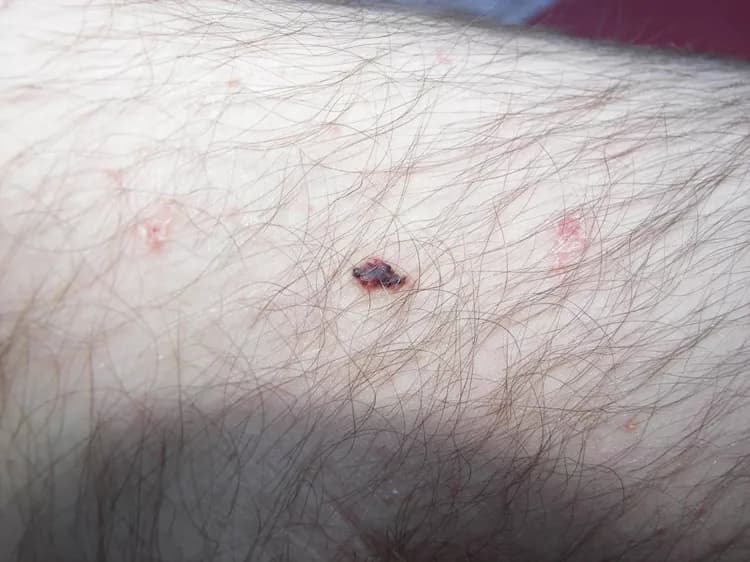What are the other Names for this Condition? (Also known as/Synonyms)
- Campbell De Morgan spots
- Senile Angioma
- Senile Hemangioma
What is Cherry Hemangioma? (Definition/Background Information)
- Hemangiomas are benign malformation of blood vessels that can occur in a number of tissues such as the brain, kidney, liver, lung, skin, and nasal cavity
- Cherry Hemangiomas are benign growths composed of small blood vessels that occur on skin tissues. They are typically small, cherry-red papules ranging from the size of a pinhead to a quarter inch in diameter. These benign tumors can sometimes rupture and bleed if injured
- Cherry Hemangiomas are often observed in individuals over the age of 30 years. Exposure to certain chemicals and a family history of the condition are certain risk factors associated with such hemangiomas
- The cause for development of the condition is not yet well understood. Some studies though, show a genetic component, linking them to MicroRNA 424
- While Cherry Hemangiomas are generally asymptomatic, they may be treated for cosmetic purposes. The treatment options include removal of the tumor.
- Currently there are no specific methods or preventative techniques for the formation of Cherry Hemangiomas; however avoidance of certain risk factors may reduce the likelihood of developing this condition
Who gets Cherry Hemangioma? (Age and Sex Distribution)
- Cherry Hemangiomas are most common in individuals over the age of 30 years
- It can affect individuals of all races, ethnic backgrounds, and genders across the world
What are the Risk Factors for Cherry Hemangioma? (Predisposing Factors)
The following risk factors contribute to Cherry Hemangioma development:
- Cherry Hemangiomas are often an inherited condition. Individuals with a positive family history are more likely to develop the condition
- Exposure to certain chemicals, such as mustard gas, 2-butoxyethanol, bromides, and cyclosporine, are associated with the development of Cherry Hemangiomas
It is important to note that having a risk factor does not mean that one will get the condition. A risk factor increases ones chances of getting a condition compared to an individual without the risk factors. Some risk factors are more important than others.
Also, not having a risk factor does not mean that an individual will not get the condition. It is always important to discuss the effect of risk factors with your healthcare provider.
What are the Causes of Cherry Hemangioma? (Etiology)
- The exact cause for development of Cherry Hemangiomas is unknown
- Since family history is an important risk factor, it may be caused by genetic mutations that are yet to be well-characterized
- Studies have shown that extremely low levels of MicroRNA 424 (a protein) can cause rapid cell growth and division causing Cherry Hemangiomas
What are the Signs and Symptoms of Cherry Hemangioma?
Cherry Hemangiomas are generally asymptomatic and do not present any signs and symptoms.
- They are typically small, cherry-red papules ranging from the size of a pinhead to a quarter of an inch in diameter
- Cherry Hemangiomas can either be flush with the skin or project from the surface
- Sometimes, these benign tumors may rupture and bleed, if they are injured
How is Cherry Hemangioma Diagnosed?
A diagnosis for Cherry Hemangioma includes evaluating the clinical history (physical exam) and a thorough family history. Other tools to help diagnose the condition may include:
- A visual assessment by the physician can help diagnose the condition
- If necessary, skin biopsies may be performed to rule-out other conditions
Many clinical conditions may have similar signs and symptoms. Your healthcare provider may perform additional tests to rule out other clinical conditions to arrive at a definitive diagnosis.
What are the possible Complications of Cherry Hemangioma?
The only significant complication of Cherry Hemangioma is bleeding from the hemangioma following injury.
How is Cherry Hemangioma Treated?
- Cherry Hemangiomas are generally asymptomatic and therefore do not require treatment
- In case of frequent bleeding or cosmetic issues related to physical appearance, individuals may choose to remove the Cherry Hemangioma
Procedures for removing a Cherry Hemangioma may include:
- Burning (electrosurgery/cautery)
- Freezing (cryotherapy)
- Laser
- Shave excision: Larger tumors may require shave excision before the use of electrosurgery
How can Cherry Hemangioma be Prevented?
- Currently there are no specific methods or preventative techniques for the formation of Cherry Hemangiomas. The condition may be caused by genetic factors
- Some studies have suggested that avoiding exposure to mustard gas, 2-butoxyethanol, bromides, and cyclosporine may reduce the likelihood of developing a Cherry Hemangioma
- If there is a family history of the condition, then genetic counseling will help assess risks, before planning for a child
- Active research is currently being performed to explore the possibilities for treatment and prevention of inherited and acquired genetic disorders
What is the Prognosis of Cherry Hemangioma? (Outcomes/Resolutions)
- Cherry Hemangiomas are noncancerous and are generally asymptomatic
- Complications leading to further or future health concerns are generally rare
- Removal of the hemangioma does not usually lead to scarring
Additional and Relevant Useful Information for Cherry Hemangioma:
The following DoveMed website link is a useful resource for additional information:
Related Articles
Test Your Knowledge
Asked by users
Related Centers
Related Specialties
Related Physicians
Related Procedures
Related Resources
Join DoveHubs
and connect with fellow professionals


0 Comments
Please log in to post a comment.